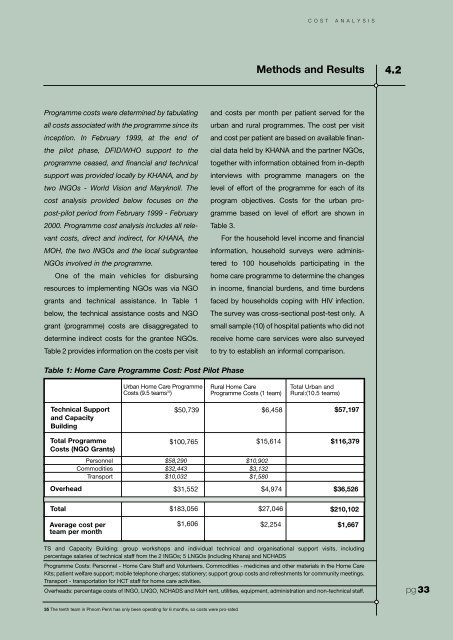PDF File - hivpolicy.org
PDF File - hivpolicy.org
PDF File - hivpolicy.org
- No tags were found...
Create successful ePaper yourself
Turn your PDF publications into a flip-book with our unique Google optimized e-Paper software.
COSTANALYSISMethods and Results 4.2Programme costs were determined by tabulatingall costs associated with the programme since itsinception. In February 1999, at the end ofthe pilot phase, DFID/WHO support to theprogramme ceased, and financial and technicalsupport was provided locally by KHANA, and bytwo INGOs - World Vision and Maryknoll. Thecost analysis provided below focuses on thepost-pilot period from February 1999 - February2000. Programme cost analysis includes all relevantcosts, direct and indirect, for KHANA, theMOH, the two INGOs and the local subgranteeNGOs involved in the programme.One of the main vehicles for disbursingresources to implementing NGOs was via NGOgrants and technical assistance. In Table 1below, the technical assistance costs and NGOgrant (programme) costs are disaggregated todetermine indirect costs for the grantee NGOs.Table 2 provides information on the costs per visitand costs per month per patient served for theurban and rural programmes. The cost per visitand cost per patient are based on available financialdata held by KHANA and the partner NGOs,together with information obtained from in-depthinterviews with programme managers on thelevel of effort of the programme for each of itsprogram objectives. Costs for the urban programmebased on level of effort are shown inTable 3.For the household level income and financialinformation, household surveys were administeredto 100 households participating in thehome care programme to determine the changesin income, financial burdens, and time burdensfaced by households coping with HIV infection.The survey was cross-sectional post-test only. Asmall sample (10) of hospital patients who did notreceive home care services were also surveyedto try to establish an informal comparison.Table 1: Home Care Programme Cost: Post Pilot PhaseUrban Home Care ProgrammeCosts (9.5 teams 35 )Rural Home CareProgramme Costs (1 team)Total Urban andRural:(10.5 teams)Technical Supportand CapacityBuilding$50,739 $6,458 $57,197Total ProgrammeCosts (NGO Grants)PersonnelCommoditiesTransport$100,765 $15,614 $116,379$58,290$32,443$10,032$10,902$3,132$1,580Overhead $31,552 $4,974 $36,526Total $183,056 $27,046 $210,102Average cost perteam per month$1,606 $2,254 $1,667TS and Capacity Building: group workshops and individual technical and <strong>org</strong>anisational support visits, includingpercentage salaries of technical staff from the 2 INGOs; 5 LNGOs (including Khana) and NCHADSProgramme Costs: Personnel - Home Care Staff and Volunteers. Commodities - medicines and other materials in the Home CareKits; patient welfare support; mobile telephone charges; stationery; support group costs and refreshments for community meetings.Transport - transportation for HCT staff for home care activities.Overheads: percentage costs of INGO, LNGO, NCHADS and MoH rent, utilities, equipment, administration and non-technical staff.pg 3335 The tenth team in Phnom Penh has only been operating for 6 months, so costs were pro-rated
















